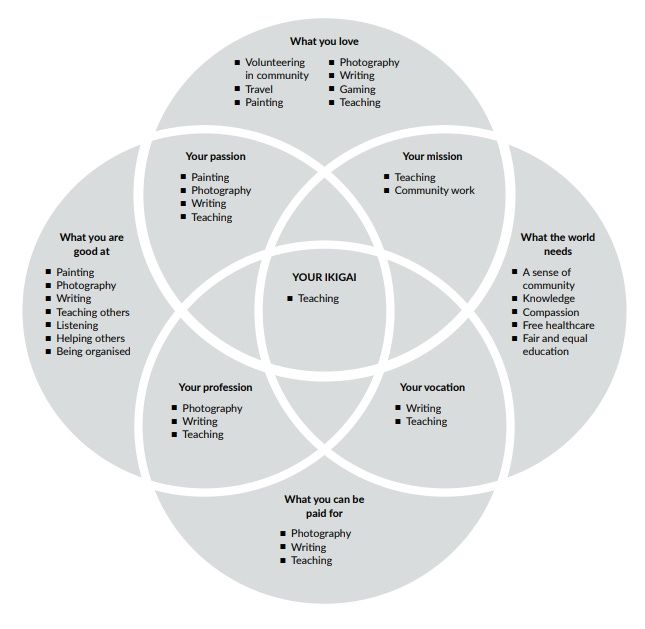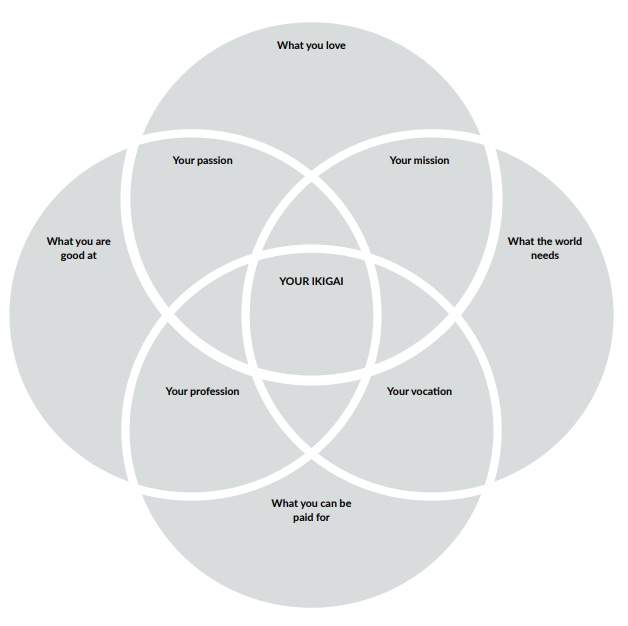A Whackadoodle World Tidbit: How to find your ikigai (The Finale)
For those of you who have been following my student's example for discovering your ikigai, we bring you: Pulling it all together, or what the heck do I do with these lists now.

I finished checking her homework in about fifteen minutes, which gave us forty-five minutes until her ride showed up. I got up to make tea while she began shoving her books back into her bag. I had just finished filling the water kettle when she called out to me, “What am I supposed to to with these?”
I looked over my shoulder. She held up four sheets of paper spread out like a deck of cards. I couldn’t see the writing, but I didn’t have to read it in order to guess their titles: Things You Love To Do, Things You Are Good at Doing, Things the World Needs, Things You Can Pet Paid for Doing. “Oh good,” I said, moving the kettle to the stove. “You hadn’t said anything, so I was afraid you’d ignored my assignment.”
“I said that I’d do it,” she reminded me irritably.
“So you did.” I grabbed two coffee mugs and a tin containing a variety of teas. Heading back to the table, I asked, “How did the list writing go?”
She shrugged. “Felt kind of weird?”
“How so weird?”
“I don’t know. It’s like I kept worrying if I was leaving something out, or doing it wrong. It’s like the lists don’t every really end do they?”
“No, they don’t,” I agreed, reaching out for her lists. “Weird or not, you seem to have a good start here. I even like your little doodles on the side.”
“It’s something I do whenever I’m waiting,” she shrugged shyly. “It helps me think.”
“Do you like doodling?”
“Sure, it’s fun.”
“So why isn’t it on your list of things you love to do?”
“It’s just something I do. It’s not like I am any good at it. Not like it could be a job.”
I shook my head and grabbed a pencil. “You mustn’t edit possibilities before exploring them.” I added doodling/drawing to her list. “Did you have any problems?” I asked not looking up.
“Not really,” she rubbed her nose, then added. “I will say that the one about what the world needs seemed kind of…”, she trailed off, uncertain.
“Weird?”
“No, not weird. It’s just its seems to me that the world needs less stuff, not more, and sure not more from me.”
“How do you mean less stuff?”
“Less war. Less fighting. Less anger. Less pollution. Less people. Less hunger. I mean that’s a list that could go on and on.”
“But doesn’t that mean that the world also needs more farmers, more conservationists, more diplomates, more negotiating, more understanding, more peace keepers?”
“I suppose so. Hang on, give me that one back.” I passed it to her and watched as she scribble a few more lines.
“Okay then,” I said once she looked up. “You want to know the next step. I have two diagrams for you.” It took me a moment to find them in my papers. “One is an example of how you use the Ikigai wheel. The other is an empty wheel for you to write your list in. I showed her the first diagram.
“As you can see,” I continued, “if you have an activity in more than one circle, say something you love that is also something you’re good at, you also write that activity where the two circles coincide.” I passed the example diagram to her. ‘If you look under ‘your passion,’ you will see painting, photography, writing, and teaching because all those activities are in both ‘what you love’ and ‘what you are good at’. You do the same for your mission, your vocation and your profession. Make sense?” I passed her the second diagram. “Here’s one that you can write in.”
She scrutinized both diagram, and it didn’t take her long to find a flaw. “My stuff’s never gonna fit in these circles.”
“Well, you have to use the circles. That’s just so you can visualize how it works. Stick to lists if that works better. Create a list of your passions, your missions, your professions, and your vocations.”
“You can have more than one mission?” she sounded confused.
“Of course. You can even have more than one ikigai. Me, for example, My ikigai includes performing, teaching, writing, communicating, negotiating, researching, fact checking, a whole bunch of things. You ikigai is not limited to one thing only. Nor is it written in stone. It’s simply a concept for living a meaningful life in which you are doing something that you love, that you are good at, that fills a need, and for which you can make a living. That’s all.”
“I guess that makes sense.” She examined the diagrams more closely. “What are those ‘trianglely’ things near the middle for?”
“Oh those represent areas in your life that are almost an ikigai, except they are missing one component. It might be something you love, like your drawing. You could even make a living at drawing if you were good enough. Plus, the world does need good graphic designers, good artists, good cartoonists. Problem is you are not good enough—yet,” I added with emphasis. “Who knows, you might get good with practice, with lessons, with time. Then it might become an ikigai. You understand?”
“I guess so,” she nodded slowly.
I decided to try making it clearer. “If you are doing something that the world doesn’t need, then even if you love the work, are good at the work, and make loads of money doing the work; you will still not be living in your ikigai. You’ll be kind of a parasite, living off the world but giving nothing back. You might feel satisfied, but never truly fulfilled. There will always be something missing.”
“Like con artist?”
“Excellent example.” I smiled broadly. “As for the others, what you are doing might delight and fulfill you, but without compensation of some kind, you can’t live. You might be comfortable doing something that you are good at, and pays well, and the world even needs, but if you don’t love what you are doing, you will always feel empty. Finally, you might be excite doing something you love, and which pays, and the world needs, but unless you are good at it, you will always feel uncertain and lack confidence. Clear?”
“Very,” she nodded, still concentrating on the diagram.
“And you know what to do next?”
“I’m pretty sure.”
“Great,” I stood up. “Then I will pour the hot water while you choose your tea, then we can work on it together until it’s time for you to leave.”
And that’s exactly what we did. I hope you will do the same.
For those of you who missed the first few steps, I have included links to them below. Not only will you learn how to uncover you ikigai, you will find a few fun words, and get my mom’s skookum recipe for banana bread.








